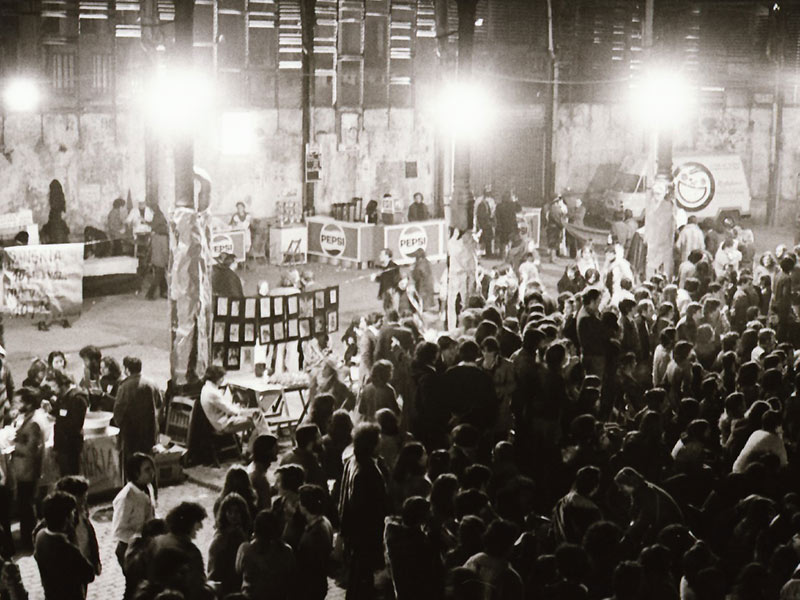Democracy (1981 - 1999)
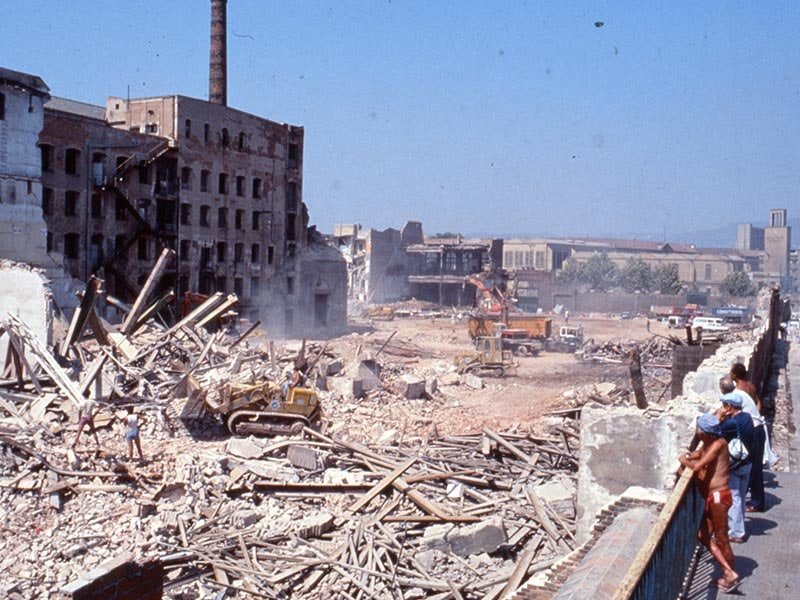
1987 – Demolition of buildings for construction of Olympic Village.
Xefo Guasch discusses the Barcelona club scene after Franco.
Everything opened wide, but as I mentioned it had already started opening five years ago. It started opening all the dictatorship, but Franco was already falling, everyone expected someone to kill him some day. But Franco died in bed like anyone else. Regarding clubs, there weren’t many progressive clubs. There were clubs in neighborhoods, that you could go during the evening to flirt, I had friends who went there during the evening to flirt in those clubs. Then there were posh clubs, like Bacarrà, there was ‘Las Vegas’, it was rock’n’roll in the Aribau street. But we specially went to one that was called Jazz Colon, it was at the end of the Rambles. The Rambles here in Barcelona, back then was a bit of a thing… people of Barcelona didn’t go often. They still don’t go often, there are many people from Barcelona who don’t cross the Diagonal street, they stay at Peralta. But well, the Rambles now are something full of toursists that you can’t even walk. But people didn’t go there often. There were some clubs like the Jazz Colon, with a DJ that I think was Toni Romero, that later was with us, and there went the American Marines. There was a time that the American ships came here to Barcelona and when the marines landed they went specially to dance ot the Jazz Colon and also a small bar called Kentucky. There was a lot of prostitution on the lower side of the Rambles. So in the Jazz Clon it was the progressives, no that we were many, the Amercian Marines and some whores, but not many. The DJs played music from England or music brought by the American Marines. The clubs in Peralta were still playing the typical French music and al lthat. After the Jazz Colon they opened one name ‘Els Enfants Terribles’ [lit. the terrible youths], it still is there, the Jazz Colon hasn’t been opened for a long while. In the ‘plaça Reial’ [lit. Royal square] there was the Jamboree, it was one of the first places where Jazz was played, it was then closed for ten years but is now open again. But I most of all remember the Jazz Colon, where you danced with fantastic music, with the American marines, the hippies (those were us) and everyone danced, you danced, and that’s it.
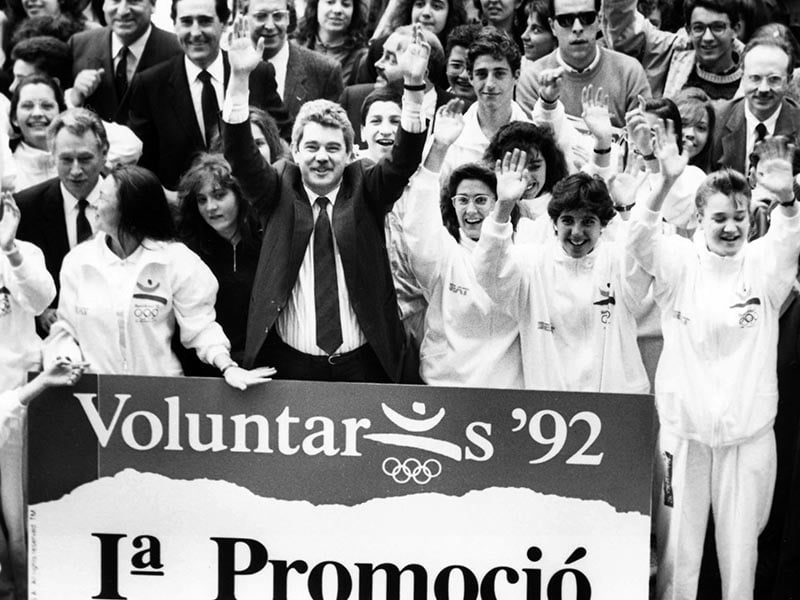
1989 – Mayor Pasqual Maragall awards certificates to first 750 volunteers for Barcelona Olympics.
Agustí Molins shares an anecdote about the Catalan language. I have an anecdote from a schoolmate who tells me, “When we went to make the first graffiti, with chalk, we went I don’t remember where furtively, hidden, and we didn’t know how to spell Catalonia.” Because we didn’t study Catalan, we studied Spanish. It was also somewhat forbidden to study Catalan. I don’t remember it personally, but my parents did have it forbidden to speak Catalan. He would tell me, Agustí, I didn’t know how to spell ‘Catalunya’ with the ‘ny’.

1986 – Felipe González and Pasqual Maragall visit Barcelona Olympic Office.
Drag Queen Sergio Satanassa discusses the perils of being gay in Barcelona in the 1980s.I’ve also seen neo-Nazi or skin groups attack us, attack gay locals like Member or Grease. I was inside and the door would open. Because back then gay clubs were closed, just a closed door with a doorbell you rang, they checked you through a spyhole and let you in, it wasn’t an open place. So you’d be in a club, Member for example, there was a knock on the door, you saw only a boy, open the door and rushed in 15 or 20 skinheads with baseball bats and start hitting everyone. Or in Gracia avenue across Diagonal, it must have been, I don’t know, the 80 something. You’re going with friends and suddenly… Since I was already like this and it didn’t exist back then, they didn’t attack me because they thought I was just a woman, but they attacked my friends. One almost lost an eye due to a spiky baseball bat, and well, there were still very tough situations, very difficult. Back then I knew it but wasn’t so conscious of… I went out like this to do my daily life, take the subway, do everything; it was a social rebellion. But I was really exposing myself to anything, from a beating to getting killed.
Drag Queen Sergio Satanassa discusses the burgeoning Drag Queen scene.Yes, well, the history of transvestism in Spain… I’m going to tell you about my experience. I, my experience as I mentioned, started by going everyday like this because I wanted to and it wasn’t seen at all. When I started going to gay clubs, when I was 18, there was a doorbell, all hidden and dark, and transvestism barely existed at all. I spent over 10 or 12 years in Barcelona working completely alone because there was no Drag Queen phenomenon or transvestism. The most was that you could go to a club at night and maybe see a guy that performed as a ‘folclórica’, or Rocío Jurado, or Isabel Pantoja or something like that, they performed and quickly removed his make up and changed his clothes to go to the street. Everything was hidden. So I decided I’d go like this and at first the gays didn’t understand why I dressed like this, it took me a while for the gay audience itself to accept me for going like this. Because it wasn’t something logical or approved. So I spent 10 or 12 years that due to dressing like this I started to get jobs as a public relations, entertainment, showbusiness… but I was completely alone for many years. After the movie Priscila and the popularization of the Drag Queen movement, there started to appear transvestites and Drag Queens from everywhere. Regarding transvestism and transsexuality, there were few. It was impossible for a transvestite or a transsexual to have a normal job, they all worked the streets. They didn’t have any other choice. Now you can find a transsexual that’s an administrator, hairdresser, or something else, any sort of career. But back then, for a transvestite or a transsexual, who really has an issue because they aren’t comfortable with their sex and it’s the worst that can happen, someone who is in another body, the only choice they had was simply prostitution. Luckily that has changed, but there’s yet much fight left for the right of transsexuals. There’s a lot of transphobia now too.
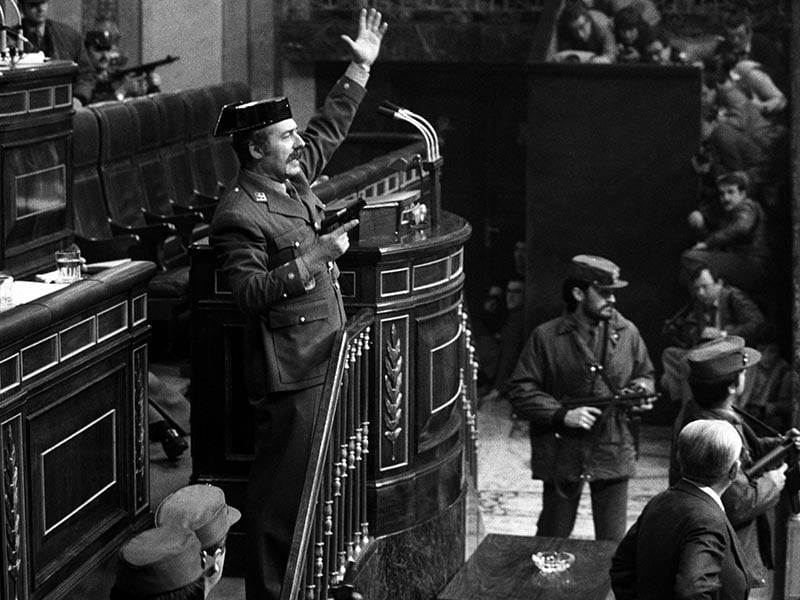
1981 – coup attempt 23-F Antonio Tejero seizes congress of deputies.
Carme Solé Vendrell discusses the Catalan proclivity for forming pacts. I think this is the true strength of Catalonia. Catalonia is the place in the world with more associations, more sports clubs, more guilds, since… These traditions have been there since the middle ages. And that’s Catalonia’s strength. The people’s capacity to fight, to band together to get things done. It is very ‘aquarian’ in that way, the ‘age of aquarius’ [song used for the aquarius commercial, not the astrology thing I think, although both could be related to it] which humanity has apparently entered. It’s about sharing, doing things together. Individualism is outdated. If we want to advance as a people, we need to band together. We can’t do it alone.
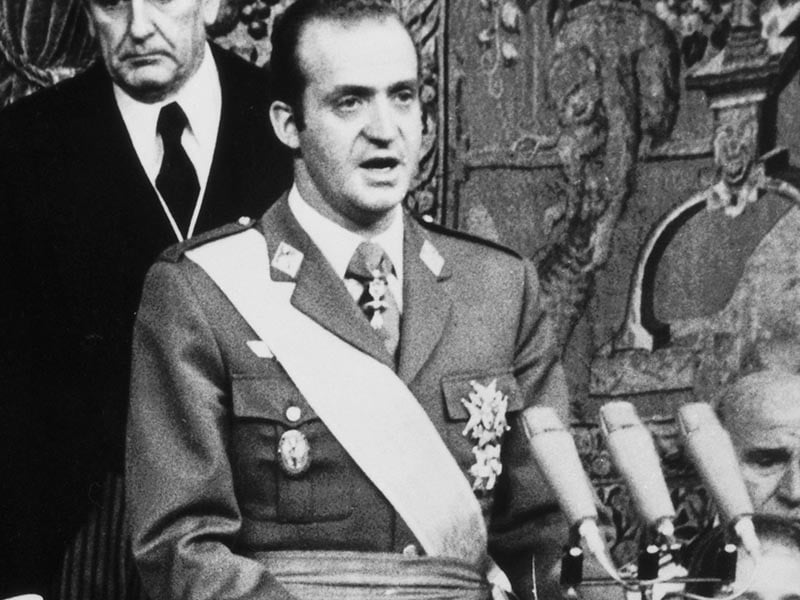
1981 – King Juan Carlos I addresses the coup attempt by Tejero.
Jordi Pablo discusses the origin of the correfoc. Let’s see, what do you want me to tell you about correfocs? Well, I had a very direct participation in the creation of correfocs, but why do you call it correfocs nowadays? I would ask that to whom is asking this question to me, because… why do you call it correfoc? Of course, if you dig up a little, you will realice that before 1980, correfocs did not exist That is, it is a modern tradition based on one of the most important festive troupes of the Corpus, which was the interlude of hell Devils are one thing, dragons an other one, and an other different one is the correfoc, they are different things, right? Devils were hell’s representation, a series of characters with masks and fire coming out of their horns They may or may not go by the side of very inventive troupes formed by not just dragons, but also oxes, mules… there’s a complete festive iconography Each village would have one or two, but if you go back in time, in the most primitive Corpus, they had lots of those That is, in the Corpus of the beginning of the XIXth Century in Barcelona, that is, in the 1850-60s, they would be almost all the troupes Of course, the thing is they recovered them 20 years ago, and as it is said in Italian, ‘se non è vero, è ben trovato’, right? It is a folklorist recovery, right? And there are a few theories on Correfocs, but as I was saying, I saw that when they recovered the Mercè’s festivities It is not that they recovered the Mercè’s festivities, but they were in total decay because they were Francoist festivities, they would have a few music bands and that was almost it And with the democracy in the 1975-76, they started to be recognized, and I took part as consultant in the city council to redo this celebration and this tradition And making it as a modern festivity Okey, then, here, there was a moment in which a troupe of devils came to Barcelona, they had already been here sometimes in 1870, but they did not come here after that And they said ‘we’ll bring here some devils from Tarragona’, and of course, people were astonished because it was barely announced, because actually, it was very embryonic And people in Barcelona did not know what that was They would go through tight streets… and well, people were scared because people said ‘run, run, fire, fire, there’s fire there!’ and they would run away, right? And this word was very lucky, let’s say, because this ‘run, run, fire, fire’ was what was said there, and it turned out to ‘runfire’ [correfoc] After that, there was a poet, friend of mine, called Joan Brossa, who sadly is no longer among us, and he did a poster in 1980 which said ‘oh, correfoc’ He was being ironic… about this popular shout, right? And from that moment, well, whatever you want, now there are correfocs in all the corners, let’s say Well, I talked a lot a bout this… but, well.
Daniel Anglada explains the Caga Tio Xmas tradition. The ‘caga-tió’… The ‘caga-tió’ would be… we have this tradition here, I know outside of Catalonia it’s not very extended, more like not at all. I lived it at my place, my grandfather was an ebony worker. We had a log that we had shaped as a sort of piglet. You paint it some eyes, give it the snout shape and put a little hat on it. And for a month you take care of it. You spend a month serving it food every night and tomorrow, when you wake up, there’s no food, the ‘tió’ has eaten it. That’s what makes the ‘tió’ grow and get fat. Why? Because it represents that the better one feels, the more one eats, the more one can give. As a seaman that’s something that comes first in ships, If you’re not properly fed, you can’t perform on board. And fatigue, while it comes from getting tired, it come earlier or harder by the lack of a good diet. I’m not talking of eating, but properly eating. So we fatten the ‘caganer’, feed it well so that it can shit well. And the 25th, its day, we sing it its song and hit it with a cane. What those hits with the cane do is activate the nerve and digestive systems of the log and it drops presents. It’s similar to the three wise men, a story from the east, a special magic, then the ‘caganer’ is our own Catalan magic.
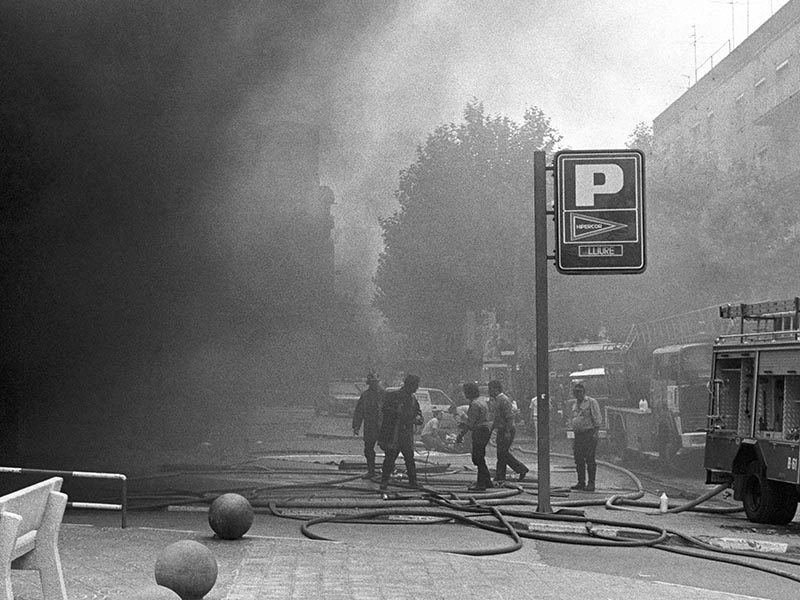
1987 – Emergency workers deal with casualties of the hipercor bombing by ETA.
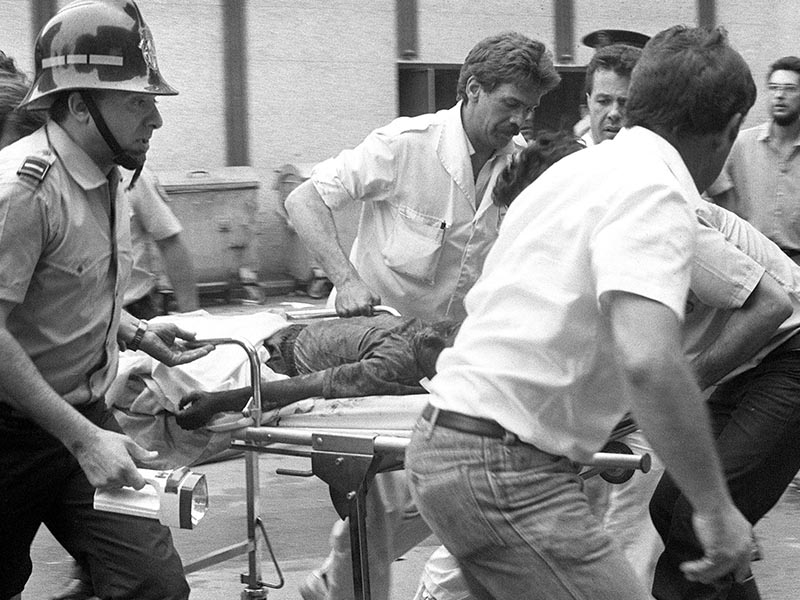
1987 – The hipercor bombing of Barcelona by ETA.
Conrad Son discusses his entry into the porn industry. Because everyone could, when the first video cameras were available, everyone made their own movies. There appeared distributors, well, I’ll give it a shot. I remember ‘Chorizo de Cantimpalo’, which was a huge success, they sold tons of copies. And well, in the 99, not so long ago but a while ago, I made the first porno movie in Catalan. A bit to bring this affiliation to politics too. And, of course, ever since the 96 when I made my first movie, which I made for ‘Canal Plus’, I remember with International that I made, it was a tv show, I always mixed the music and all that. Until now well, last year, it was all cinema, cinema. To the video and from the video there’s now people who film with a phone.
